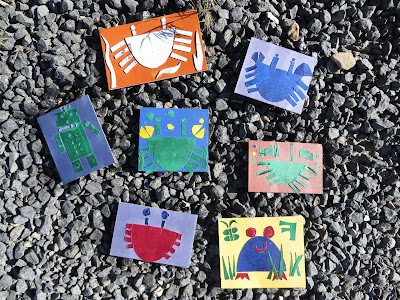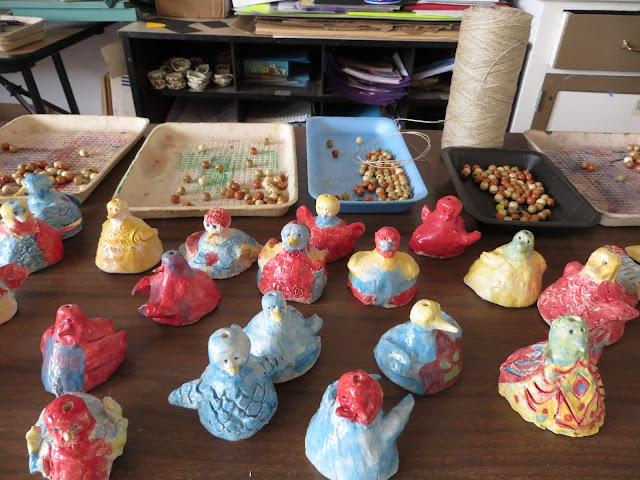Welcome! Please use this site as a resource for art project ideas in the classroom or at home. Comments are welcome and appreciated.
Wednesday, December 4, 2013
Monday, November 25, 2013
ALPHABET SOUP CLAY PENDANTS
SUPPLIES:
Clay, rolling pins, Fiskars scissors, wooden stylus to poke holes, lace, leaves, alphabet pasta, glaze, brushes, twine or yarn, beads
Tuesday, November 5, 2013
SOCK PUPPETS
Sock puppets are fun to make and require only a few supplies. Start by placing a sock of your choice onto your hand to get an idea of where the mouth piece should go. Cut a piece of felt into the shape of an oval and glue it onto the sock. Tacky glue works well. Allow time for it to dry then test it out on your hand as seen above. Use buttons, material, yarn, google eyes, pipe cleaners, and anything else you can think of to bring your puppet to life.
The puppet above is a sock puppy with a strong inclination to play fetch!
Tuesday, April 23, 2013
OJO DE DIOS
 |
| Ojo de Dios in its beginning stage. |
This is a great project for many ages and calls for just yarn, sticks, and glue or wire. Popsicle sticks work well, although the images posted here were made with wooden dowels.
Begin by fastening two sticks perpendicular to each other using glue, thread, or fine wire. Take a generous strand of yarn, tie it to the center of the crossed structure and begin weaving by going around the sticks clockwise or counter clockwise.
Experiment with different weaves by going over-around, under-around, or over-around, over-around. This probably won't make sense until you try it, but once you do, you'll see how easy it is.
 |
| Ojo de dios showing two different weaving patterns. |
In this photo you can see two different patterns. One pattern is a repetition of over-around, and the other is a repetition of under-around.
 |
| Beautiful Ojo de Dios using only one color. |
We have used multiple colors in some Ojos, but you can see that if the pattern is varied then only one color can also be effective.
 |
| Ojo de Dios with smaller ones on the tips. |
Here is an Ojo de Dios that has smaller ones attached to the tips of the center Ojo. The Huichol tribe in Mexico is known for their beautiful Ojos, although it is called something else.
Wednesday, April 10, 2013
COLLAGRAPHY FOR KIDS
In its simplest terms, a collagraph is a print of a collage. If you're going to use a press it will be best to build your collage on mat board or some other flat, sturdy material. Mat board was used for the image display here.
You can use yarn, paper clips, bubble wrap, and other odd ball materials to build your collagraph, but we kept ours simple and built them using only thin cardboard. Cereal boxes and other food boxes are a perfect weight and a great way to recycle. They're thin enough for even first and second graders to cut.
Make sure to carefully glue every edge and corner so that it stays put. You can place heavy books on top to be sure. Use quality glue if you can.
After you finish gluing your image it is important to apply a protective coat to the plate (the plate is your collagraph image on board). Mod podge or watered down glue (not washable glue!) works well for this. The coating will allow you to make multiple prints without losing pieces of the image by way of usage.
Ink it up with printing ink or a substitute and run it through your press. If you don't have a press, wooden spoons are the perfect tool to make your print by hand.
After you are finished making all the prints you want, cover the plate with heavy foil to make an aluminum foil relief print. I will post that as a different project later on.
Here are some plates that Kindergarten through Second grade made. They have not been printed but have been coated with a protective spray and are ready to go.
 |
| Unused collagraph plate with mod podge coating. |
Make sure to carefully glue every edge and corner so that it stays put. You can place heavy books on top to be sure. Use quality glue if you can.
After you finish gluing your image it is important to apply a protective coat to the plate (the plate is your collagraph image on board). Mod podge or watered down glue (not washable glue!) works well for this. The coating will allow you to make multiple prints without losing pieces of the image by way of usage.
 |
| Inked collagraph plate ready to be printed. |
 |
| Collagraph plate and print. |
 |
| Different plates for collagraphs made by K's and 1st grade. |
 |
| Robots! |
Tuesday, April 2, 2013
SUMI-E or BLACK INK PAINTING
 |
| Sumi-e or black ink painting seems to be a very calming art project for every age. |
 |
| The elegant simplicity of the natural elements and the pleasing contrast of black and white with all shades in between lend themselves to a highly satisfying painting experience. |
 |
| When a classroom full of 25 energetic children is completely quiet and all are engaged, you know you've found a great project! |
 |
| I have purchased specialty sumi-e brushes for my classroom, but a round #6 or #8 watercolor brush works well too. |
 |
| My students and I took some time to learn about sumi-e painting before we started. It's purely fascinating, and engaging in the process allows for a deeper appreciation of the art. |
WOODEN MANNEQUIN SKETCHES
 |
| Third, fourth and fifth grade students sketched wooden mannequins that were placed at each table. |
 |
| Students focused on using loose lines, and they also paid extra attention to spatial relations. For example, they asked such questions as "Where is the wrist in relation to the hip?" and so on. |
 |
| Displayed together, students are able to appreciate the many different styles, perspectives, and approaches to this project. EXCELLENT WORK EVERYONE! |
Wednesday, March 20, 2013
MAGAZINE COLLAGE
My students were given a 5" X 5" square of foam core and some National Geographic and Arizona Highways magazines. They were instructed to find a full page landscape scene to be used for their background. When they found a page that they liked, they traced their foam core onto the page, then cut the square out of the magazine page and glued it onto their foam core.
The next step was to find and cut out interesting images. A small ziplock snack bag with their name on it is useful to store images until the next class. When they had a variety of images, students then arranged them in different ways before gluing them onto their foam core to discover what worked best.
After gluing the magazine images onto their foam core, students embellished their collage with yarn, beans, glass beans, sequins, and a final coat of mod podge.
The next step was to find and cut out interesting images. A small ziplock snack bag with their name on it is useful to store images until the next class. When they had a variety of images, students then arranged them in different ways before gluing them onto their foam core to discover what worked best.
After gluing the magazine images onto their foam core, students embellished their collage with yarn, beans, glass beans, sequins, and a final coat of mod podge.
MOLAS of PANAMA, HOPI STYLE!
I started this project by showing my students photographs of some indigenous people of Panama and their famous textiles known as MOLAS. We discussed reverse applique as it is used in the making of a mola and the hard work that it requires. Each student in the fourth grade made their own version of a mola using construction paper, then my early finishers made an oversized paper mola. I hung their work for everyone to see and enjoy.
My Hopi students almost always infuse some aspect of their culture into their artwork. I love to see where they take their projects. In the large bird posted here, you can see a turquoise necklace, a feather on a headband, and tootsies or moccasins on the feet of the bird. The large piece is framed by a border of geometric designs frequently found in Hopi art (other tribes too).
Excellent Work Fourth Grade!
My Hopi students almost always infuse some aspect of their culture into their artwork. I love to see where they take their projects. In the large bird posted here, you can see a turquoise necklace, a feather on a headband, and tootsies or moccasins on the feet of the bird. The large piece is framed by a border of geometric designs frequently found in Hopi art (other tribes too).
Excellent Work Fourth Grade!
Wednesday, February 27, 2013
CLAY BIRD BELLS
 |
Wednesday, February 6, 2013
BUFFALO SCRATCH ART
Subscribe to:
Posts (Atom)






.JPG)






















